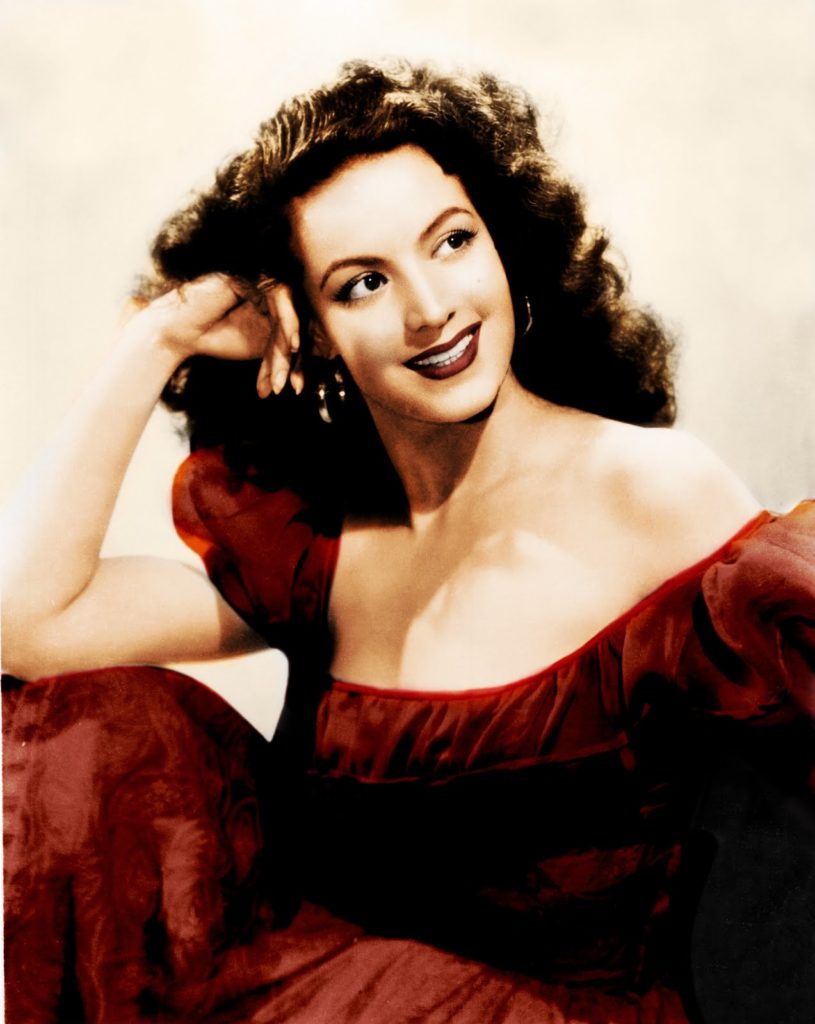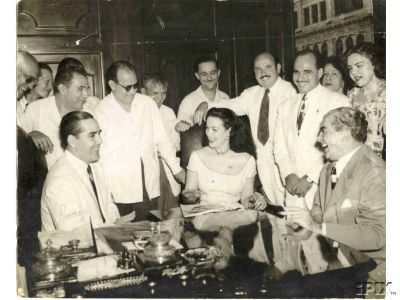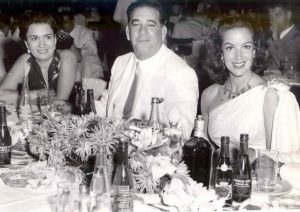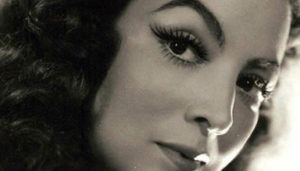 MARIA FELIX “MARIA BONITA” EN LA HAVANA. PHOTOS.
MARIA FELIX “MARIA BONITA” EN LA HAVANA. PHOTOS.
Anunciar el arribo de Maria Felix a La Habana y tenerla efectivamente en la capital cubana, era una noticia capaz de vender la edición completa de cualquier diario.
Llegó desde Mérida el 26 de octubre de 1949 y acerca de cómo la recibieron, dejemos que ella misma lo diga: “Yo tenía referencias de cómo me querían en La Habana, pero lo de esta tarde ha sido más de lo que esperaba”.
Se alojó en el Hotel Nacional, y necesidad tuvo en más de una ocasión de protección policial, porque los admiradores no se contentaban con verla, obsequiarle flores y dedicarle algún que otro poema: querían algo tangible… y hubo quien tiró de su vestido en el afán por conservar un recuerdo material de María Bonita.
La publicidad desplegó todos sus medios durante aquellos cinco días, los debates políticos pasaron a segundo plano y el pandillerismo que agitaba la ciudad se tranquilizó un tanto para que la gran estrella durmiera plácidamente en sus noches habaneras. Mientras, la prensa reproducía su rostro, sus declaraciones y ella lo pasaba inolvidablemente bien.
Escribe un cronista social de aquellos días: “Llegó deslumbrante. La sonrisa, al aparecer en la escala del avión, iluminó todas las bocas. Fue una exclamación unánime y espontánea: ¡Qué bella es! Cuando nos hicieron la gracia de pasarnos, la pista estaba invadida. Invadida de público. En su mayoría dignísimo, discreto, curioso de ver de cerca la espléndida belleza mexicana que nos visitaba. Pero, ¡ay!, había de todo en aquella vorágine humana. Había de todo. ¡De lo peor también! ¡Hasta carteristas!”. Vuelve Nicolás Guillén: “Y no solo carteristas –añadiremos por nuestra cuenta y por cuenta de María Félix-. Ello fue cuando esta apenas había dado unos pasos, detúvose pálida y confusa. Luego enrojeció hasta la raíz del cabello. ¡Pero es imposible!, murmuró al cabo. ¿Qué había ocurrido? Algo insólito y lamentable. Aprovechando la jadeante confusión, una cálida mano masculina se deslizó de modo inconveniente por el cuerpo de la artista, que apenas pudo reprimir un grito de asombro, pero que por supuesto no reprimió su desagrado”.
Comenta Ramón Vasconcelos –la llamada pluma de oro del periodismo cubano- en su periódico Alerta: “Se cuentan cosas que nos ridiculizan y deprimen. Con el pretexto de conservar souvenirs suyos, hubo quienes le tiraron del cabello, quienes intentaron arrancarle pedazos del traje, llevarse un adorno a viva fuerza; y lo que es más bochornoso, hacerla objeto de exploraciones groseras…”
Qué ocurrió? Digámoslo de una vez. Un hecho infame y oprobioso. A María Félix le habían palpado el glúteo en plena pista de aviación. Era el mes de octubre de 1950, y María Bonita, La Doña, estaba por primera vez en La Habana.
DE NUEVO EN LA HABANA.
De nuevo en La Habana se habia presentado María, vestida de blanco y majestuosa, con el solsticio de verano del año de 1955. Se alojó en el hotel Comodoro del barrio de Miramar y accedió a responder cuantas preguntas quisieran hacerle los reporteros. Al de la revista Bohemia aseguró que uno de los sueños de Jorge Negrete y de ella era venir juntos, pero que la muerte de aquel, en 1953, se había interpuesto.
Acudió, sí, al cabaret Tropicana. Escribe, a propósito, Nicolás Guillén en su crónica: “Cuando apareció, deslumbrante de belleza, pasada ya la media noche, y tomó asiento frente a una mesa espléndidamente preparada para ella, el gran mundo allí reunido la saludó con una tempestad de aplausos y exclamaciones. Muchas voces le suplicaban que saliera a la pista a decir algunas palabras, no ya de gratitud, sino de mera cortesía, pero se negó en redondo. La audiencia se rompía las manos aplaudiendo y enronquecía gritando… Nada. Intervino entonces el empresario de María Bonita […] y solo consiguió que la artista se pusiera de pie y saludara fugazmente con una sonrisa lejana, como desprendida de Sirio, a la concurrencia alborotada.
En el teatro América no la haría mejor. Subió al escenario y dijo solamente: “Mírenme”. Pero el público allí congregado pudo mirar y admirar a su antojo a María Félix en su triunfante imagen de hembra en celo, con aquellos ojos negros y grandes, la boca pulposa, las caderas firmes y altas, los senos discretos, los muslos poderosos.
Pese a tanto calor y color, La Doña, al igual que lo hacía en México, se mostró en La Habana fría y distante, transcurrió en un limbo estratosférico e inalcanzable, sin importarte que la opinión pública se mantuviera en vilo con su presencia y pendiente de su altivez y sus silencios.
Por la fecha de sus presentaciones de 1955 en el cabaret Montmartre y el escenario de Radio Centro, María acumulaba una filmografía importante. Trece años habían transcurrido desde que diera pruebas de su talento en ‘El Peñón de las Ánimas, a la que sucedieron otras cintas de éxito, entre ellas ‘Enamorada’, de 1946; ‘Río Escondido’, de 1947; ‘Mare Nostrum’, de 1948; ‘Una mujer cualquiera’, de 1949; ‘La noche del sábado’, de 1950; ‘La corazonada’, filmada un año después; ‘French can-can’, de 1954 y varias más que los cinéfilos cubanos aguardaban ansiosos para disfrutarlas a plenitud.
Maria Felix y sus visitas a la Habana marcaron exclusivos cintillos en los mejores periodicos de la epoca y su sentir y admiracion del pueblo cubano hacia la bella “Maria Bonita”.
 MARIA FELIX “MARIA BONITA” IN LA HAVANA. PHOTOS.
MARIA FELIX “MARIA BONITA” IN LA HAVANA. PHOTOS.
Announcing the arrival of Maria Felix in Havana and having it effectively in the Cuban capital, was news capable of selling the complete edition of any newspaper.
She arrived from Mérida on October 26, 1949 and about how they received her, let her say it herself: “I had references of how they wanted me in Havana, but this afternoon was more than I expected”.
She stayed at the Hotel Nacional, and need had more than one occasion of police protection, because admirers were not satisfied with seeing her, giving her flowers and dedicating an occasional poem: they wanted something tangible … and there were those who pulled her dress in the eager to preserve a material memory of María Bonita.
The publicity displayed all its means during those five days, the political debates took second place and the gangs that agitated the city calmed down somewhat so that the great star slept peacefully in its Havana nights. Meanwhile, the press reproduced his face, his statements and she had an unforgettably good time.
https://youtu.be/eZpnWjrlyx8
Write a social chronicler of those days: “It came dazzling. The smile, appearing on the scale of the plane, illuminated all the mouths. It was a unanimous and spontaneous exclamation: How beautiful she is! When they gave us the grace to pass us, the track was invaded. Invaded from public. Most dignified, discreet, curious to see up close the splendid Mexican beauty that visited us. But, alas, there was everything in that human vortex. There was everything. Of the worst too! Up pickpockets! ” Nicolás Guillén returns: “And not only pickpockets – we will add on our own account and on behalf of María Félix-. This was when she had barely taken a few steps, she stopped pale and confused. Then he blushed to the roots of his hair. But it’s impossible !, he mumbled at the end. What had happened? Something unusual and regrettable. Taking advantage of the panting confusion, a warm male hand slid inconveniently through the body of the artist, who could barely suppress a cry of amazement, but that of course did not suppress his displeasure.
Ramón Vasconcelos comments -the so-called golden pen of Cuban journalism- in his newspaper Alerta: “Things are told that ridicule and depress us. With the pretext of preserving souvenirs of his, there were those who threw his hair, who tried to tear pieces of his suit, take an adornment with vigor; and what is more embarrassing, making it the object of gross explorations … ”
What happened? Let’s say it at once. An infamous and disgraceful fact. Maria Felix had felt her gluteus on the airfield. It was the month of October 1950, and María Bonita, La Doña, was for the first time in Havana
AGAIN IN HAVANA.
Once again in Havana, María had presented herself, dressed in white and majestic, with the summer solstice of the year 1955. She stayed at the Comodoro Hotel in the Miramar neighborhood and agreed to answer as many questions as the reporters wanted to ask her. The magazine Bohemia said that one of the dreams of Jorge Negrete and her was to come together, but that the death of that, in 1953, had been interposed.
He went, yes, to the Tropicana cabaret. Nicolás Guillén writes, incidentally, in his chronicle: “When she appeared, dazzling in beauty, past midnight, and took a seat in front of a table splendidly prepared for her, the great world gathered there greeted her with a storm of applause and exclamations Many voices begged him to come out on the floor to say a few words, not just of gratitude, but of mere courtesy, but he refused in a round. The audience broke their hands applauding and hoarse screaming … Nothing. Then the businessman of Maria Bonita intervened and […] he only managed to get the artist to stand up and greet with a fleeting smile, as if detached from Sirius, the crowded crowd.
In the America theater I would not do it better. He went on stage and said only: “Look at me.” But the public gathered there could look and admire at will Mary Felix in her triumphant image of female in heat, with those big black eyes, the pulpy mouth, the firm and high hips, the discreet breasts, the powerful thighs.
In spite of so much heat and color, La Doña, like she did in Mexico, showed herself in Havana cold and distant, passed in a stratospheric and unreachable limbo, without caring that the public opinion stayed in suspense with her presence and pending of his haughtiness and his silences.
By the date of her 1955 performances at the Montmartre cabaret and the Radio Centro stage, María had an important filmography. Thirteen years had elapsed since he gave proof of his talent in ‘El Peñón de las Ánimas’, which was followed by other successful films, including ‘Enamorada’, from 1946; ‘Río Escondido’, of 1947; ‘Mare Nostrum’, 1948; ‘A woman anyone’, of 1949; ‘The night of Saturday’, of 1950; ‘The hunch’, filmed a year later; ‘French can-can’, from 1954 and several more than the Cuban moviegoers waited anxiously to enjoy them to the fullest.
Maria Felix and her visits to Havana marked exclusive headbands in the best newspapers of the time and her feeling and admiration of the Cuban people towards the beautiful “Maria Bonita”.
Agencies/ CubanNow/ Leonardo Depestre/ Extractos/ various/ Internet Photos/ YouTube/ Arnoldo Varona/ www.TheCubanHistory.com
THE CUBAN HISTORY, HOLLYWOOD.









